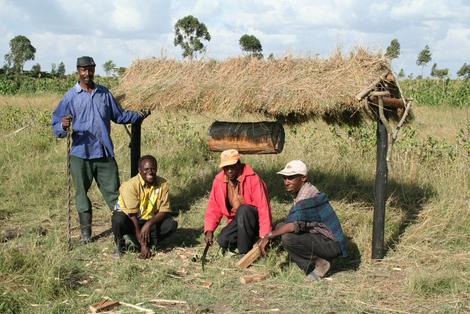- Norway protects eels.
- 3d interactive training materials for beekeeping and sorghum cultivation.
- More on the Hawaiian GM taro story.
Nibbles: Bats and bananas, Extension, Russian animal harvests, Rice improvement, Sacred groves
Nibbles: Meadows, Bees, Books
- Ecological manifesto cum plant giveway cum art. ‘Nuff said.
- The effects non-native plants have on native plants and pollinators. Say what?
- Old books minable for ancient wisdom. You don’t say.
Buzz off, elephants told
![]() From a FBFriend, a link to Treehugger.com’s story of how beehives are being used to keep African elephants from raiding farmers’ fields. Such a fine story, from a group at Oxford University that happens to include an old mate. 1
From a FBFriend, a link to Treehugger.com’s story of how beehives are being used to keep African elephants from raiding farmers’ fields. Such a fine story, from a group at Oxford University that happens to include an old mate. 1

Oxford’s press release has the details. In essence, farmers build a fence that consists of beehives strung together on a wire. When elephants brush against the wire the beehives swing and the bees come out swinging. And even thick-skinned elephants are afraid of bees, which sting them around the eyes and — ouch — up the trunk. The result is that “a farm protected by the beehive fence had 86 per cent fewer successful crop raids by elephants and 150 per cent fewer raiding elephants than a control farm without the fence.”
This makes no sense; how can something be 150% lower than something else? Time to check the original paper.
Over the 6-week study period, the two focal farms experienced twenty successful crop raids involving 133 elephants. Farm A, with the beehive fence, experienced seven successful raids involving 38 elephants. Farm B experienced thirteen raids (86% more than Farm A) involving 95 invading elephants (150% more than Farm A; X2 = P < 0.001, df 1) (Fig. 2). In addition, Farmer B recorded a further 71 elephants in eight failed raid attempts that he prevented from entering his farm using his traditional deterrent tactics. In total Farm B had 21 attempted raids by 166 elephants during the 6-week trial, all of which occurred less than 500 m from Farm A. Most notably, by the end of the harvest season, Farm B had almost no crops to harvest, with the farmer estimating that about 90% of his harvest had been destroyed or eaten by elephants, whereas Farmer A was able to harvest relatively successfully collecting a variety of sorghum, beans, potatoes and maize. This suggests that the fence was at least partially successful in deterring elephants.
That’s better, but not much. Almost twice the raids, involving two and a half times more elephants is how I’d put it.
Strangely, the beehives did not need to contain bees to be an effective deterrent. Just the (recorded) sound of angry bees is enough to deflect an elephant who has experienced stings. But if the hives are occupied the farmer gets honey and, presumably, better pollination too.
Short-haired bumblebee goes home
The bumblebee Bombus subterraneus is extinct in the UK — it was last seen in 1988 at Dungeness nature reserve on the south Kent coast — but has been thriving in New Zealand.
The short-haired bumblebee was exported from the UK to New Zealand on the first refrigerated lamb boats in the late 19th Century to pollinate clover crops.
It has disappeared in Britain (though it apparently is still to be found on the continent) because of “[l]oss of extensive, herb-rich grasslands, especially those containing good stands of plants of the families Lamiaceae and Fabaceae, through agricultural intensification.” But now there’s a plan to set up a captive breeding programme using the expats, with a view to reintroduction, including in restored habitats.
I could not find any information on whether the decline of the short-haired bumblebee affected the pollination of any plant species, or whether the slack has been taken up by other bumblebees. But be that as it may, this is an interesting example of assisted migration, of a sort, though I don’t think climate change has been implicated in the fate of the insect in Britain. It’s also an example of going back to former colonies to look for genetic resources that are no longer to be found in the “mother” country. Like those Hopi peaches of a few days back. Uhm, I feel another post coming on…